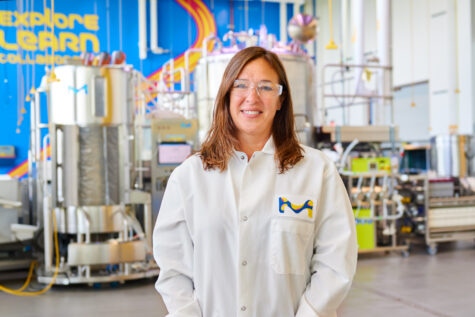Content Spotlight
Podcast: MilliporeSigma says education vital to creating unbreakable chain for sustainability
MilliporeSigma discusses the importance of people, education, and the benefits of embracing discomfort to bolster sustainability efforts.
December 21, 2023

Many see the application of AI and digitization as the solution to some of the challenges faced by the biopharmaceutical industry, MilliporeSigma looks to use the two to drive the next generation of laboratories.
With AI-design discovery deals, paperless platforms, and customers’ demands for digitization in a post-pandemic world, companies are investigating and building what they consider to be the “the labs of the future.” BioProcess Insider sat down figuratively with Karen Madden, chief technology officer for MilliporeSigma (the life sciences division of Merck KGaA), to discuss its personal journey toward the lab of the future and its outlook on the industry in general.
KM: MilliporeSigma, and the entire industry, is on a journey toward the ‘lab of the future.’ Besides our offerings for customers to speed their lab of the future as technologies evolves, right now, we are also building our own lab of the future in the Boston area, which is a very sophisticated, automated chemistry lab that will also provide our team with the ability to conduct downstream testing and analytical characterization of these molecules. It’s planned to be inaugurated in 2025.
KM: There is a need for more efficiency to come out of labs and facilities, and there are opportunities for more productive, safe, and cost-effective methods from molecule discovery to quality control through manufacturing.
For instance, bringing a drug to market still takes, on average, more than 10 years, and costs over $2 billion. Only about 10% of drug candidates evaluated in Phase I make it to market. AI and automation systems will take on more prosaic tasks, freeing the scientist to conduct experiments that require a human touch, and innovate at a quicker pace. According to market research firm, Bekryl, AI has the potential to offer over $70 billion in savings for the drug discovery process by 2028.
KM: For biomanufacturing, we need to make biological production more efficient so that we can serve more patients. The industry is buzzing about continuous processing because it will allow biomanufacturers to achieve greater efficiency, productivity, and product quality; provide a greater understanding and control of products and processes; and save valuable time, money and reduce risks.
KM: The lab of the future will integrate cutting-edge technologies and methodologies to revolutionize scientific research and development.
Some of these elements are:
Smart infrastructure
Emerging technologies, such as tech-enabled traceability and documentation
Closed loop automation and robotic systems to perform routine tasks
Other specialized instruments that enable faster and more accurate data acquisition and analysis
Inventory management and e-procurement automation
Connectivity and IoT providing seamless data exchange and remote access to experiments and equipment
Cloud computing and artificial intelligence (AI) algorithms will help extract insights from vast amounts of data – which includes enabling digital chemistry and drug discovery systems
High sample throughput platforms
KM: All of that will enable researchers to focus on more complex experiments and data interpretation, as digital technologies will enhance collaboration, data management, and analysis.
The lab of the future will also count on environmentally friendly laboratory practices to minimize the lab’s carbon footprint and promote more sustainable research. Overall, the lab of the future will merge state-of-the-art technologies, data-driven approaches, automation, and sustainable practices to accelerate scientific breakthroughs, promote collaboration, and drive innovation in various fields of research.
KM: At MilliporeSigma […] we have identified the relevance of data and digital early on, including the opportunities of AI. This is why we have created and built a company-wide data strategy early on that combines the benefits of central governance and proximity to the business and our functions following a Hub-Hub-Spoke model with a group-wide Data and AI office managing strategic architecture and governance and the business hubs working with the functional experts on the execution.
[…] we have over 150 AI initiatives, many of which are already in production or in the process of being deployed. The advent of ChatGPT has increased the momentum considerably and we have seen a lot of activity both bottom-up from within our business and functional teams and we have also invested in providing generative AI from the central point of view. The Group Data and AI team built a ChatGPT clone called myGPT@Merck that allowed for the safe use of ChatGPT with sensitive company data as early as June 2023, to name one example. Our teams have also developed software that combines AI, ML and computer-aided drug design methods, a valuable toolkit for our customers increasing the success rate of lead candidates in drug discovery and development.
KM: AI is disrupting a number of life science applications and will have an important role in the future. Whether empowering researchers in the lab to find the next scientific breakthrough or supporting customers in the manufacturing and testing of novel therapies and diagnostics, AI is at the forefront of nearly every digital initiative now underway in our Life Science business.
KM: For instance, in the field of drug discovery. As millions of people are waiting on the promise of new drugs and therapies to come to market, the utilization of AI and ML systems to accelerate and reduce the cost of drug discovery is one of the most exciting fields.
To identify potential target molecules to treat diseases, researchers traditionally carry out large screens of libraries of molecules, with numerous rounds of tests for a promising compound. The sheer size of the libraries used to screen for new drug candidates means it’s now practically impossible for individual researchers to review everything themselves – and that’s where AI and ML can help.
Generative AI has the potential to generate new content and even help us design new – small and large – molecules.
You May Also Like